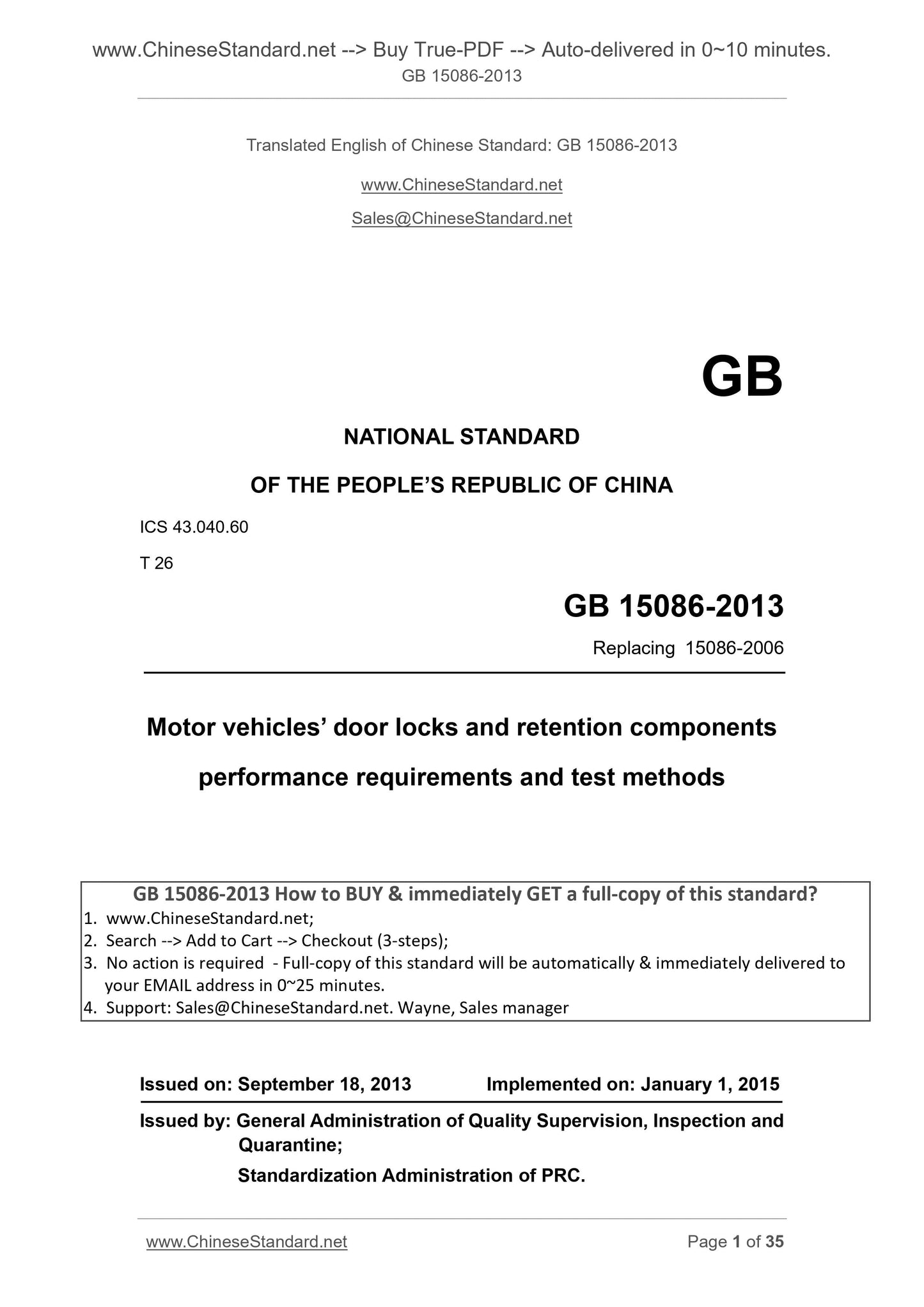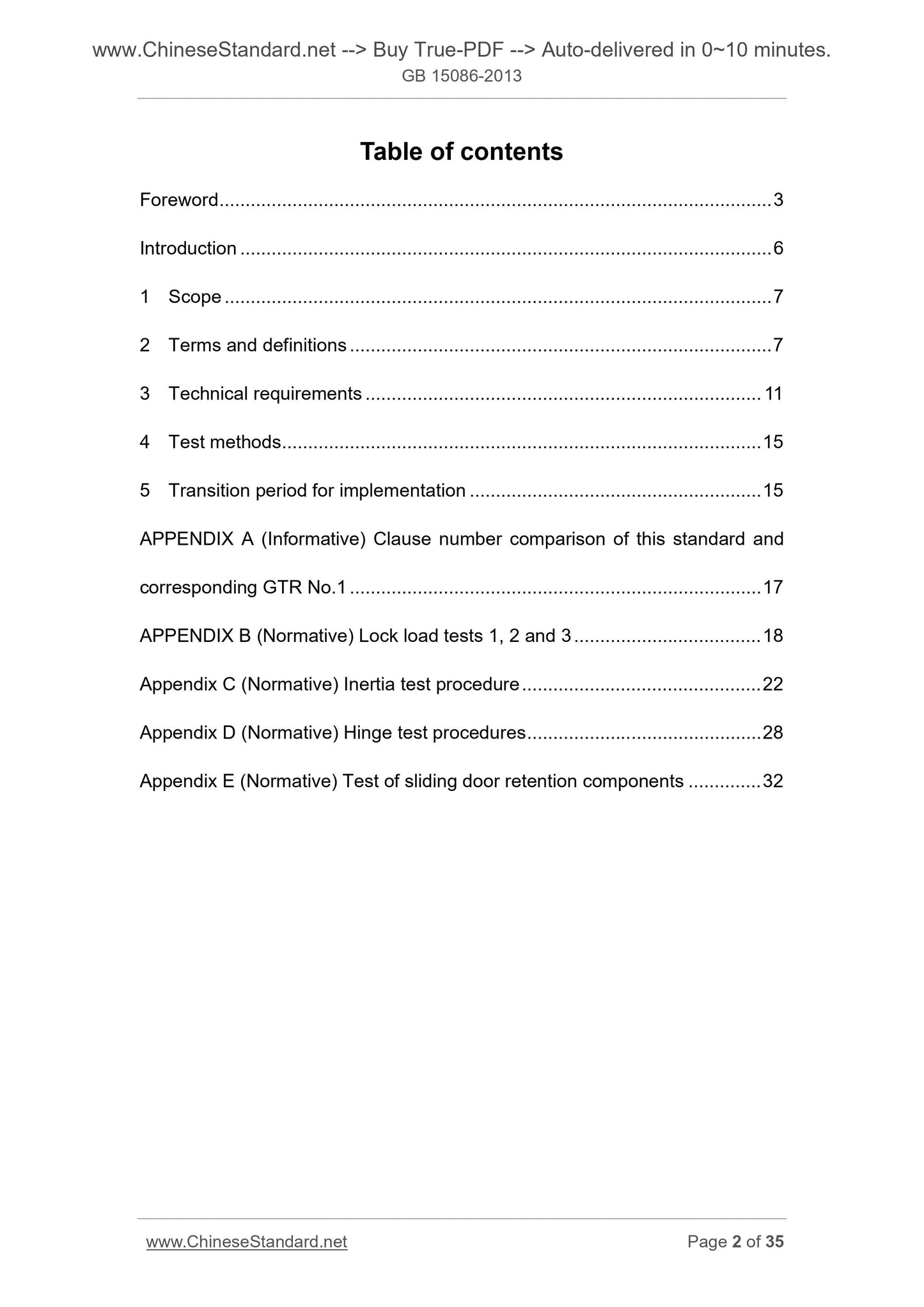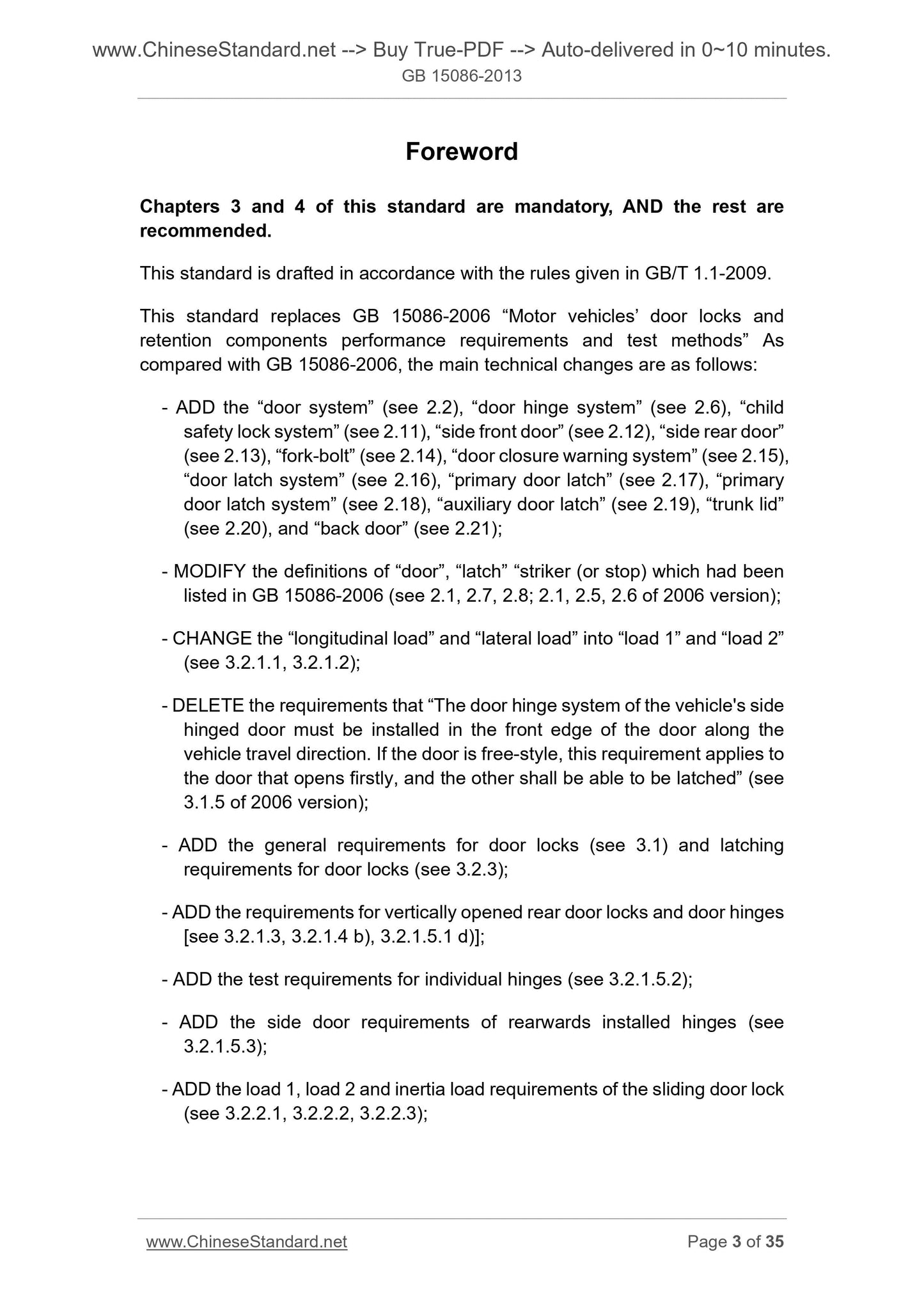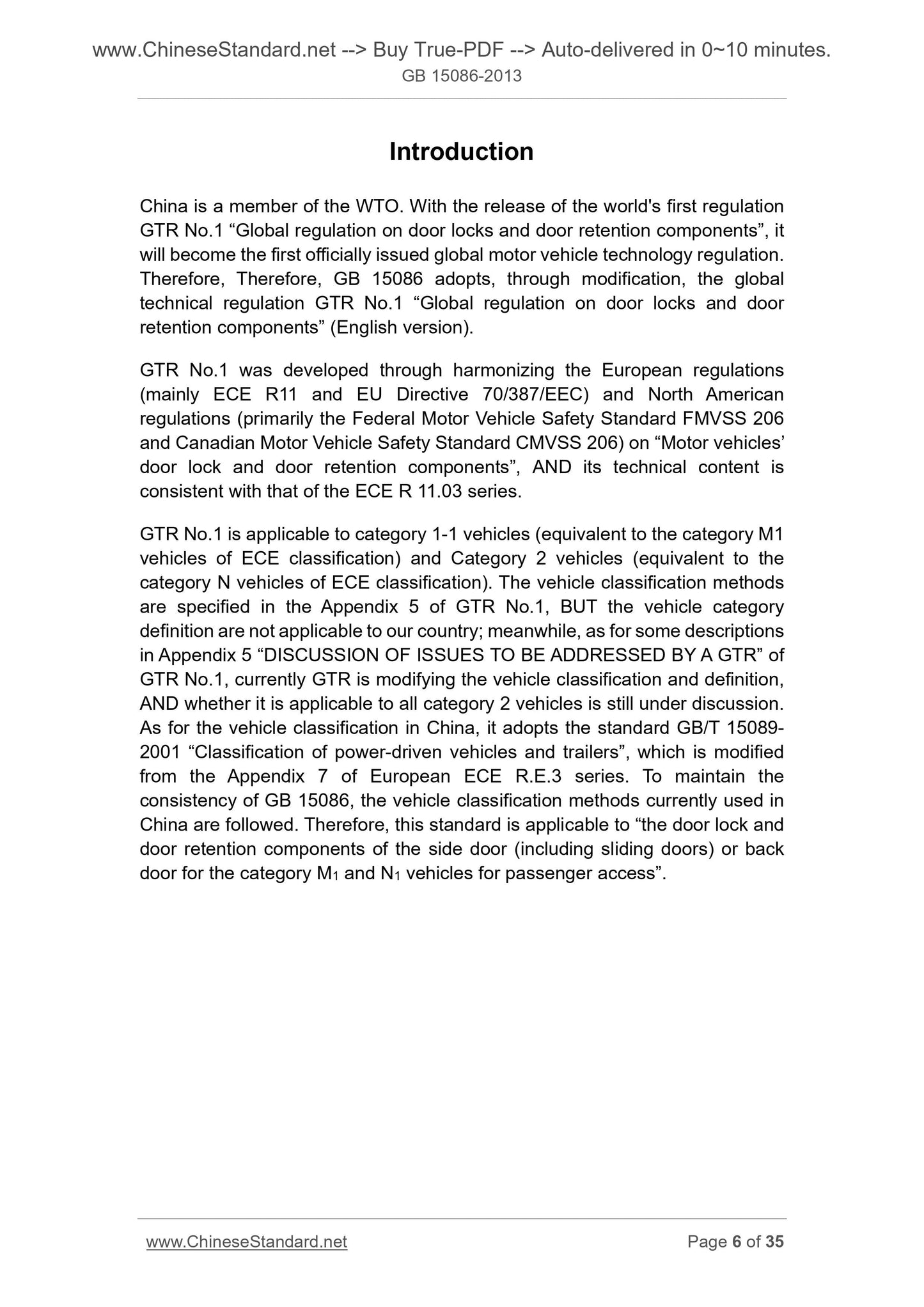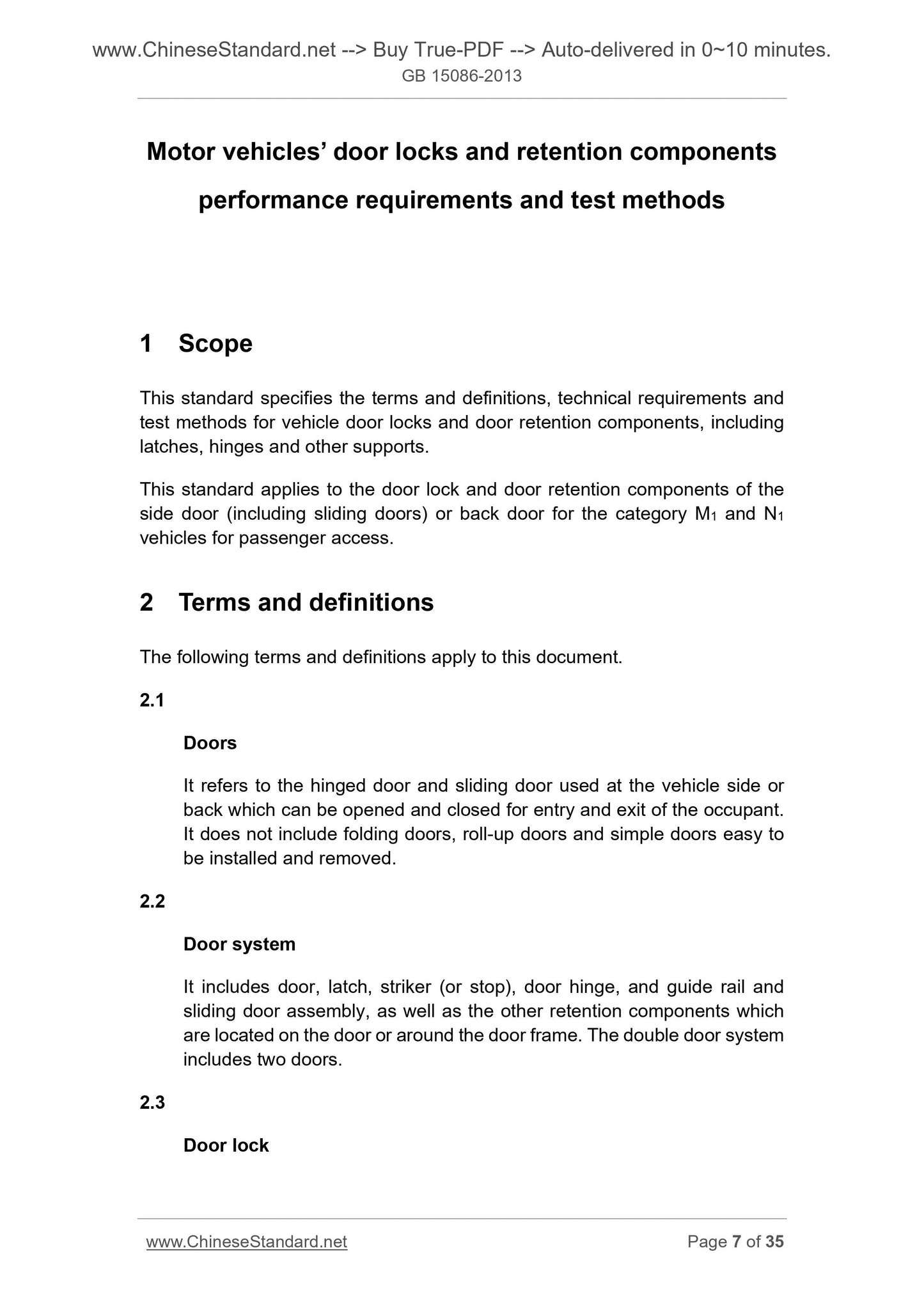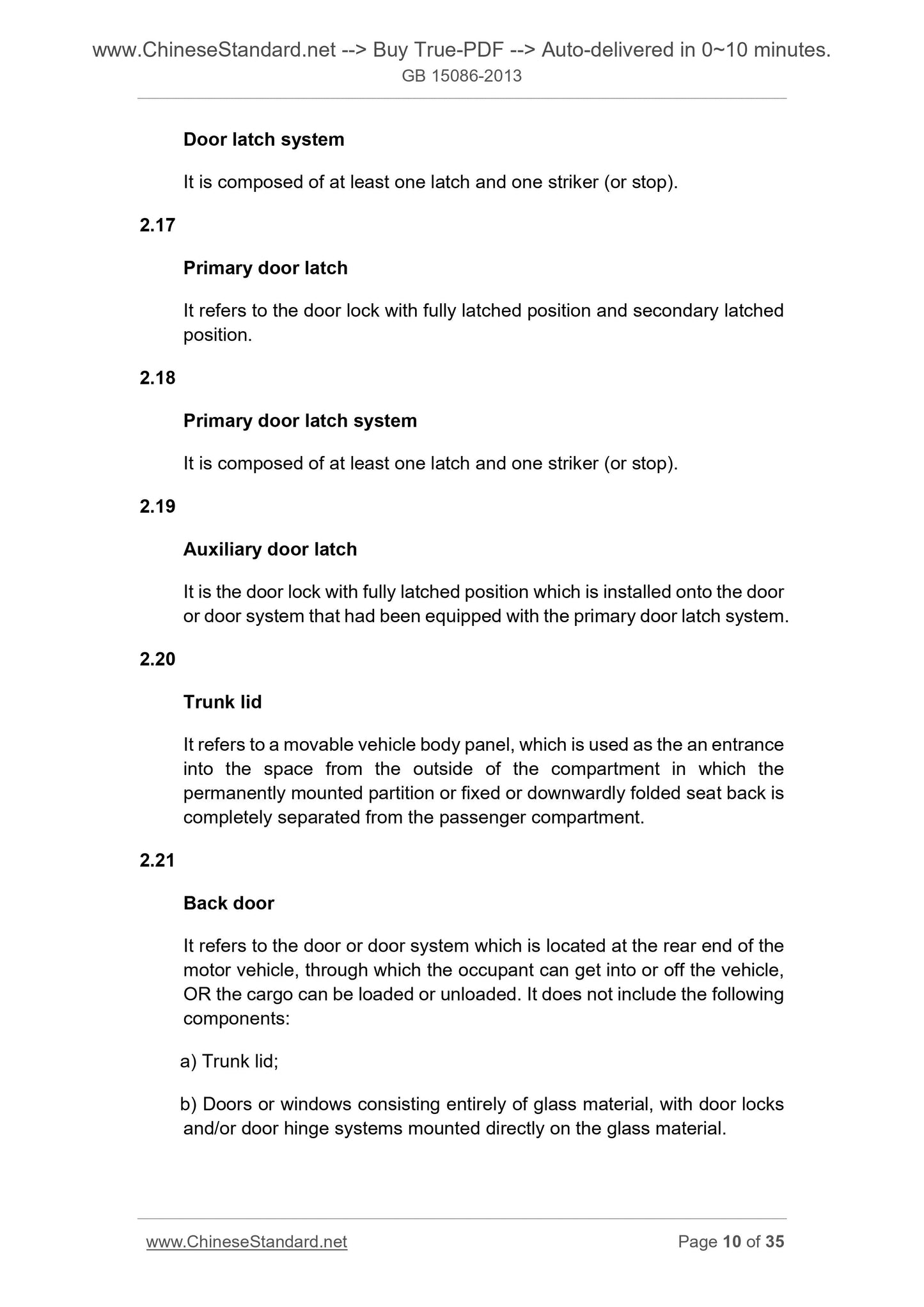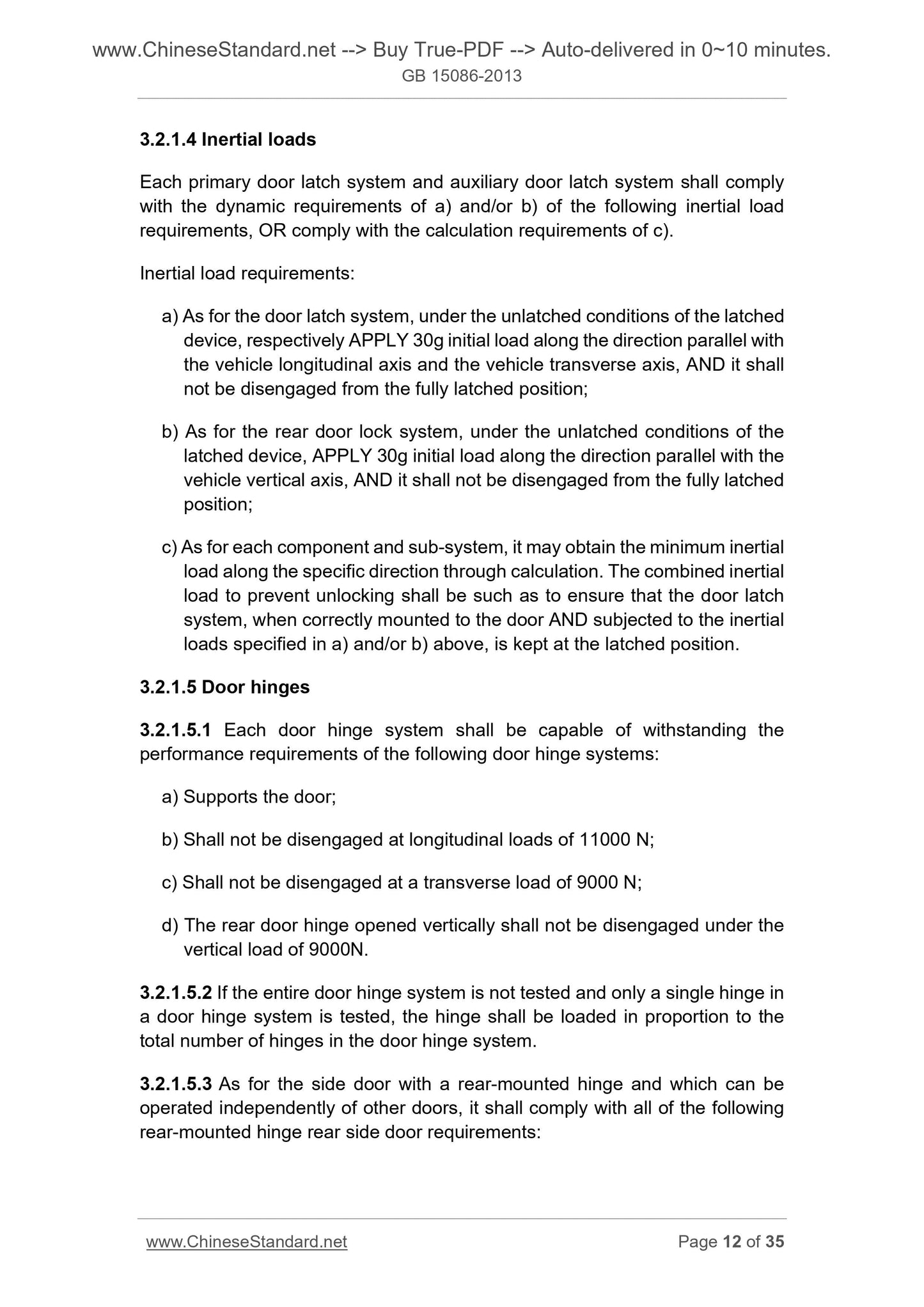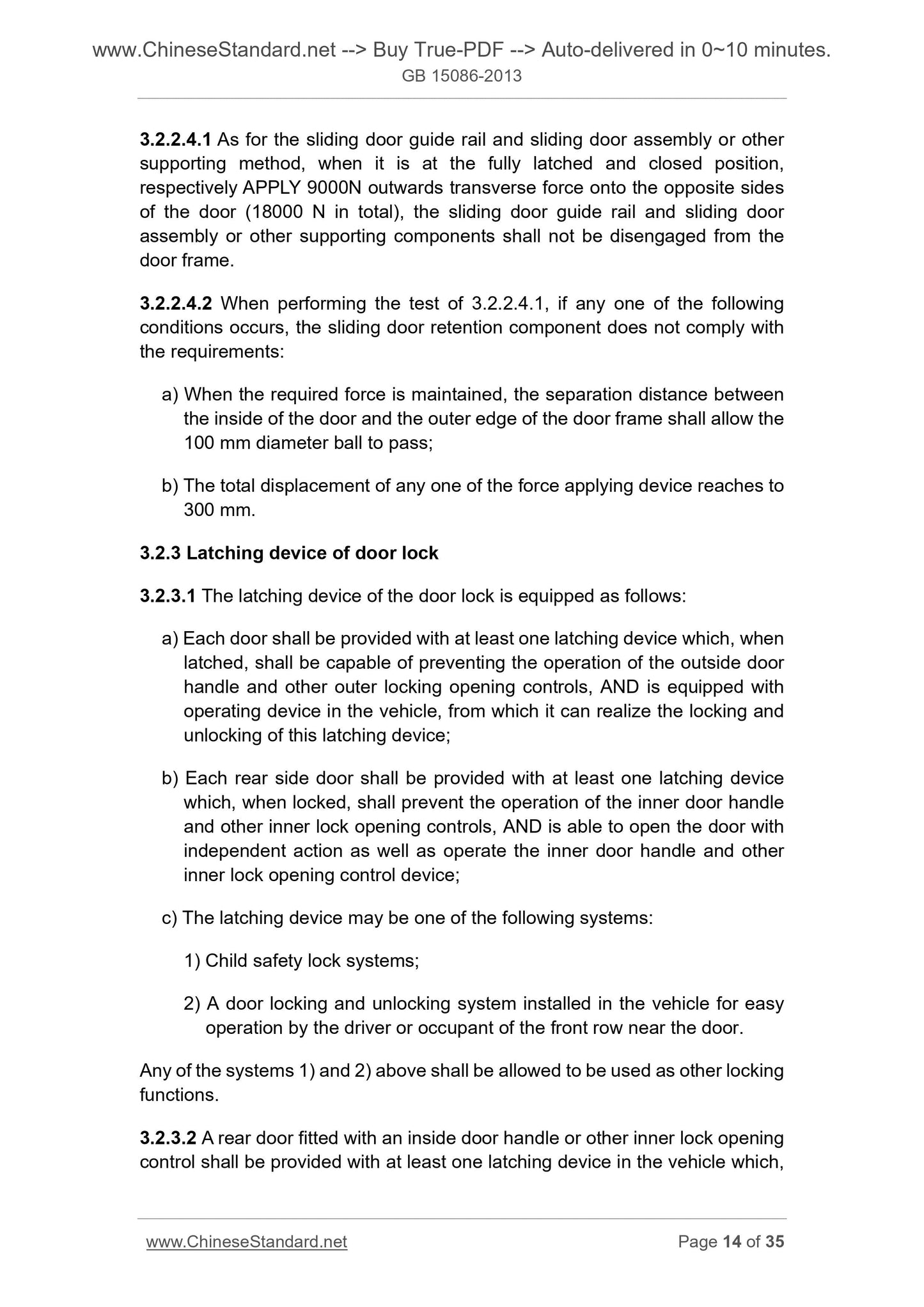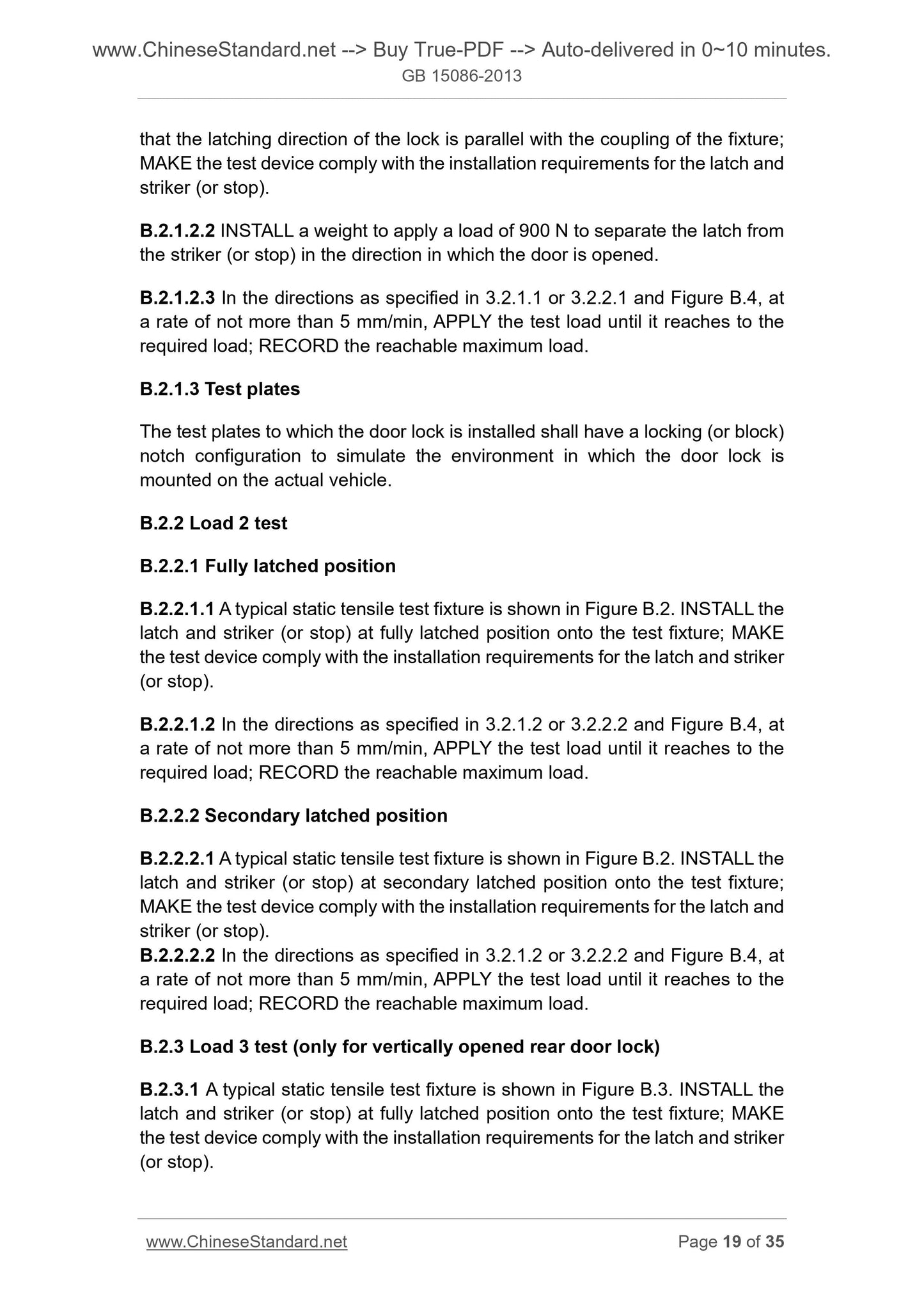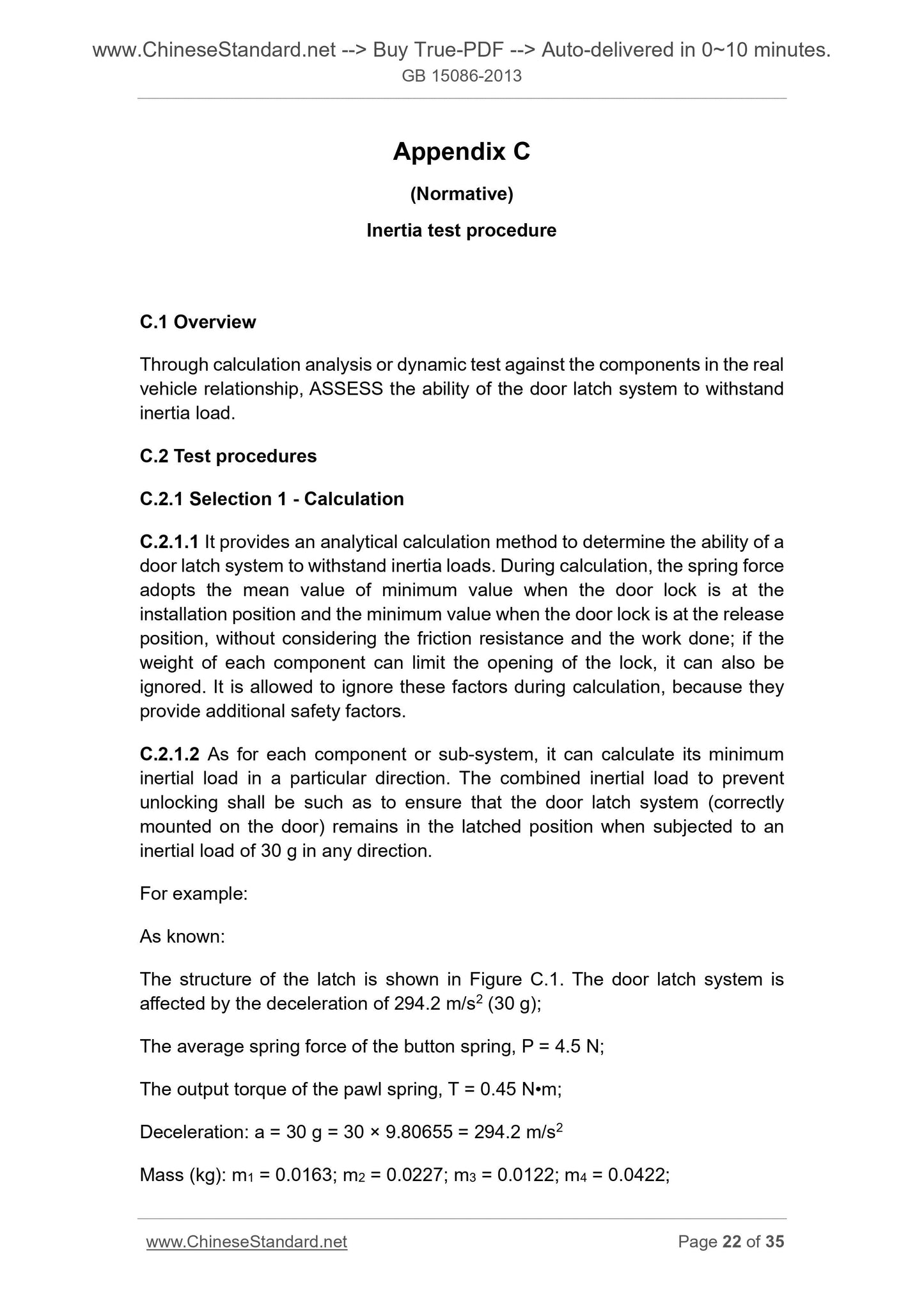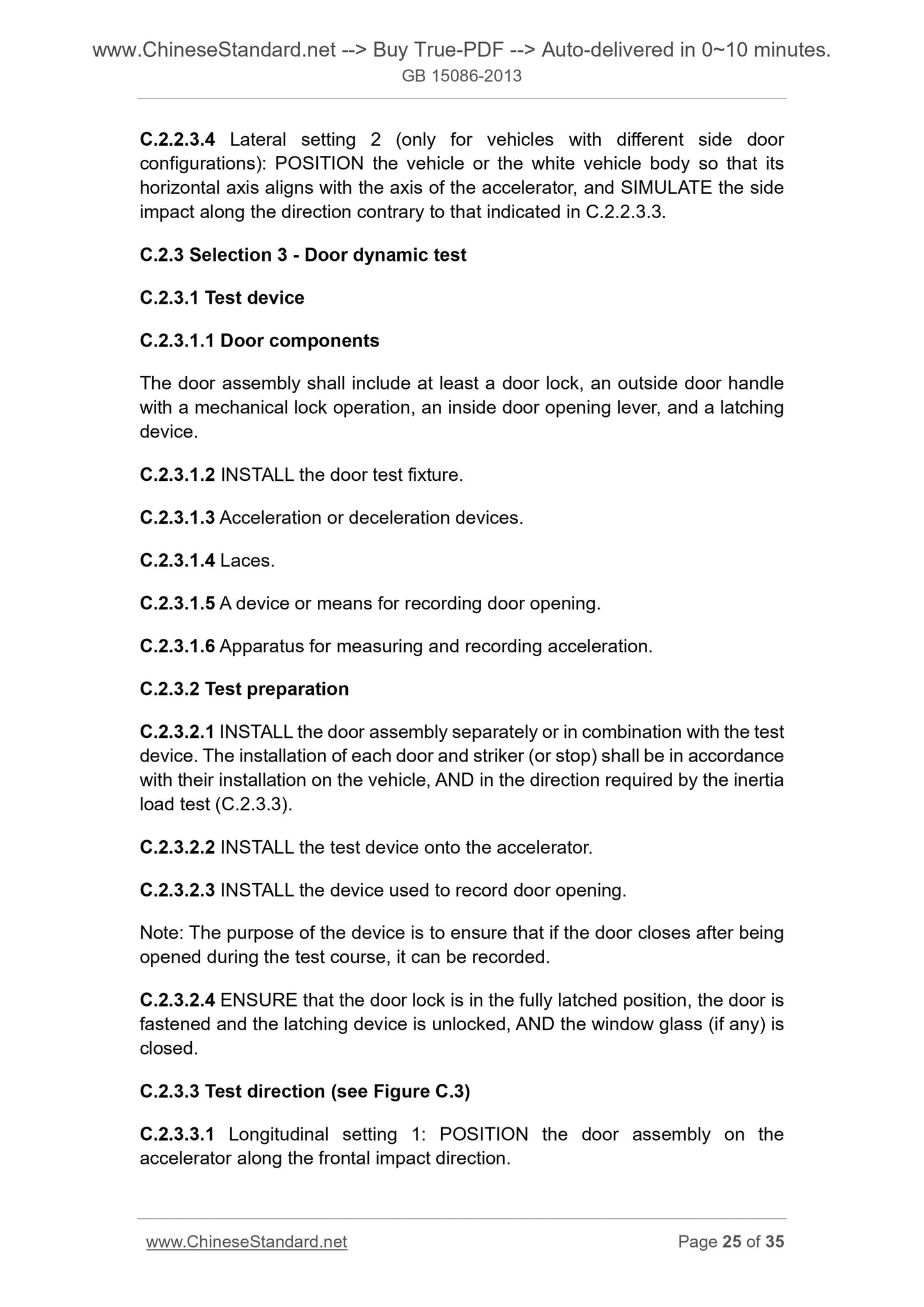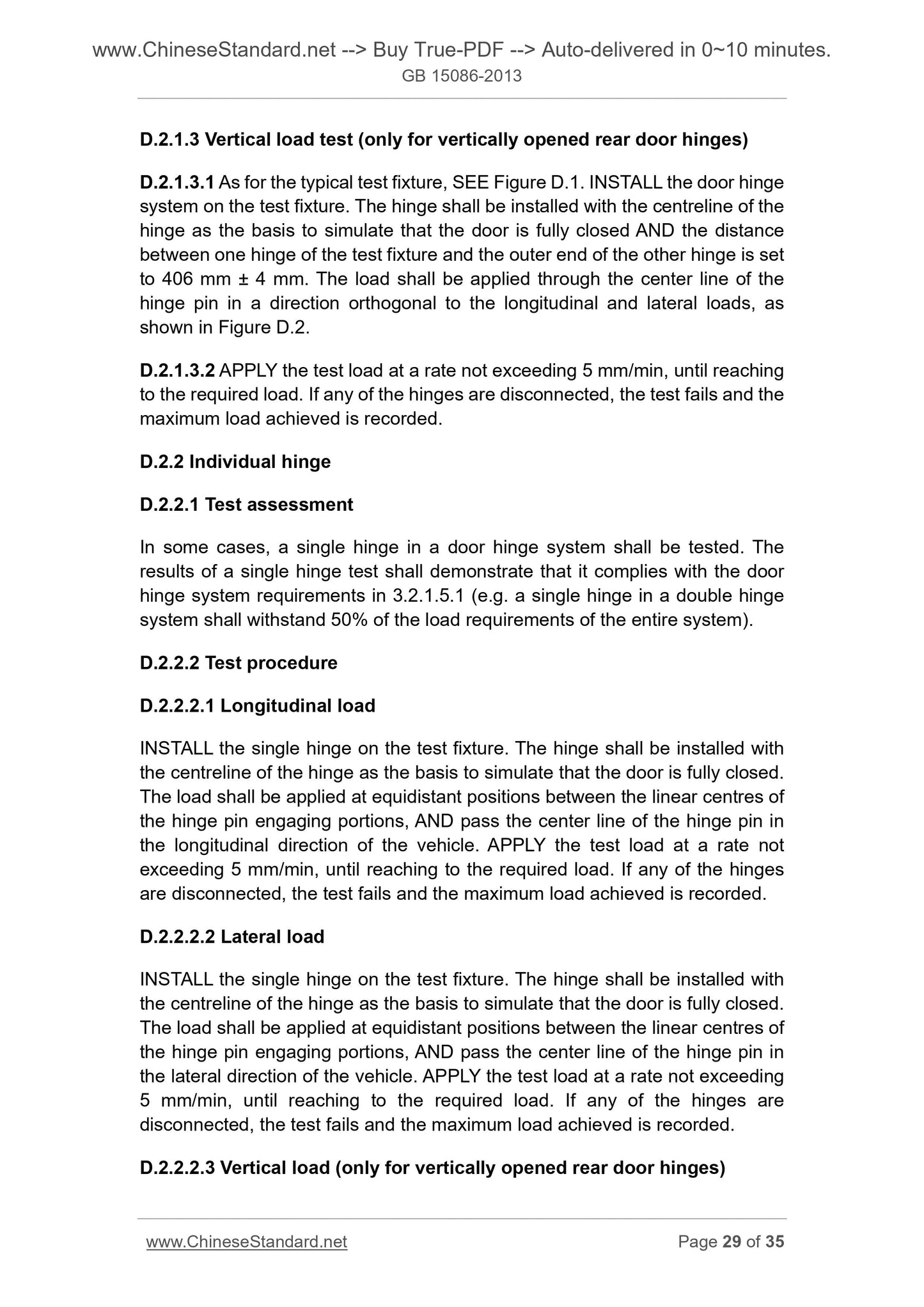1
/
of
12
www.ChineseStandard.us -- Field Test Asia Pte. Ltd.
GB 15086-2013 English PDF
GB 15086-2013 English PDF
Regular price
$85.00
Regular price
Sale price
$85.00
Unit price
/
per
Shipping calculated at checkout.
Couldn't load pickup availability
GB 15086-2013: Motor vehicle door locks and retention components performance requirements and test methods
Delivery: 9 seconds. Download (& Email) true-PDF + Invoice.
Get Quotation: Click GB 15086-2013 (Self-service in 1-minute)
Historical versions (Master-website): GB 15086-2013
Preview True-PDF (Reload/Scroll-down if blank)
GB 15086-2013
GB
NATIONAL STANDARD
OF THE PEOPLE’S REPUBLIC OF CHINA
ICS 43.040.60
T 26
Replacing 15086-2006
Motor vehicles’ door locks and retention components
performance requirements and test methods
ISSUED ON. SEPTEMBER 18, 2013
IMPLEMENTED ON. JANUARY 1, 2015
Issued by. General Administration of Quality Supervision, Inspection and
Quarantine;
Standardization Administration of PRC.
Table of contents
Foreword ... 3
Introduction ... 6
1 Scope ... 7
2 Terms and definitions ... 7
3 Technical requirements ... 11
4 Test methods ... 15
5 Transition period for implementation ... 15
APPENDIX A (Informative) Clause number comparison of this standard and
corresponding GTR No.1 ... 17
APPENDIX B (Normative) Lock load tests 1, 2 and 3 ... 18
Appendix C (Normative) Inertia test procedure ... 22
Appendix D (Normative) Hinge test procedures ... 28
Appendix E (Normative) Test of sliding door retention components ... 32
Foreword
Chapters 3 and 4 of this standard are mandatory, AND the rest are
recommended.
This standard is drafted in accordance with the rules given in GB/T 1.1-2009.
This standard replaces GB 15086-2006 “Motor vehicles’ door locks and
retention components performance requirements and test methods” As
compared with GB 15086-2006, the main technical changes are as follows.
- ADD the “door system” (see 2.2), “door hinge system” (see 2.6), “child
safety lock system” (see 2.11), “side front door” (see 2.12), “side rear door”
(see 2.13), “fork-bolt” (see 2.14), “door closure warning system” (see 2.15),
“door latch system” (see 2.16), “primary door latch” (see 2.17), “primary
door latch system” (see 2.18), “auxiliary door latch” (see 2.19), “trunk lid”
(see 2.20), and “back door” (see 2.21);
- MODIFY the definitions of “door”, “latch” “striker (or stop) which had been
listed in GB 15086-2006 (see 2.1, 2.7, 2.8; 2.1, 2.5, 2.6 of 2006 version);
- CHANGE the “longitudinal load” and “lateral load” into “load 1” and “load 2”
(see 3.2.1.1, 3.2.1.2);
- DELETE the requirements that “The door hinge system of the vehicle's side
hinged door must be installed in the front edge of the door along the
vehicle travel direction. If the door is free-style, this requirement applies to
the door that opens firstly, and the other shall be able to be latched” (see
3.1.5 of 2006 version);
- ADD the general requirements for door locks (see 3.1) and latching
requirements for door locks (see 3.2.3);
- ADD the requirements for vertically opened rear door locks and door hinges
[see 3.2.1.3, 3.2.1.4 b), 3.2.1.5.1 d)];
- ADD the test requirements for individual hinges (see 3.2.1.5.2);
- ADD the side door requirements of rearwards installed hinges (see
3.2.1.5.3);
- ADD the load 1, load 2 and inertia load requirements of the sliding door lock
(see 3.2.2.1, 3.2.2.2, 3.2.2.3);
Introduction
China is a member of the WTO. With the release of the world's first regulation
GTR No.1 “Global regulation on door locks and door retention components”, it
will become the first officially issued global motor vehicle technology regulation.
Therefore, Therefore, GB 15086 adopts, through modification, the global
technical regulation GTR No.1 “Global regulation on door locks and door
retention components” (English version).
GTR No.1 was developed through harmonizing the European regulations
(mainly ECE R11 and EU Directive 70/387/EEC) and North American
regulations (primarily the Federal Motor Vehicle Safety Standard FMVSS 206
and Canadian Motor Vehicle Safety Standard CMVSS 206) on “Motor vehicles’
door lock and door retention components”, AND its technical content is
consistent with that of the ECE R 11.03 series.
GTR No.1 is applicable to category 1-1 vehicles (equivalent to the category M1
vehicles of ECE classification) and Category 2 vehicles (equivalent to the
category N vehicles of ECE classification). The vehicle classification methods
are specified in the Appendix 5 of GTR No.1, BUT the vehicle category
definition are not applicable to our country; meanwhile, as for some descriptions
in Appendix 5 “DISCUSSION OF ISSUES TO BE ADDRESSED BY A GTR” of
GTR No.1, currently GTR is modifying the vehicle classification and definition,
AND whether it is applicable to all category 2 vehicles is still under discussion.
As for the vehicle classification in China, it adopts the standard GB/T 15089-
2001 “Classification of power-driven vehicles and trailers”, which is modified
from the Appendix 7 of European ECE R.E.3 series. To maintain the
consistency of GB 15086, the vehicle classification methods currently used in
China are followed. Therefore, this standard is applicable to “the door lock and
door retention components of the side door (including sliding doors) or back
door for the category M1 and N1 vehicles for passenger access”.
Motor vehicles’ door locks and retention components
performance requirements and test methods
1 Scope
This standard specifies the terms and definitions, technical requirements and
test methods for vehicle door locks and door retention components, including
latches, hinges and other supports.
This standard applies to the door lock and door retention components of the
side door (including sliding doors) or back door for the category M1 and N1
vehicles for passenger access.
2 Terms and definitions
The following terms and definitions apply to this document.
2.1
Doors
It refers to the hinged door and sliding door used at the vehicle side or
back which can be opened and closed for entry and exit of the occupant.
It does not include folding doors, roll-up doors and simple doors easy to
be installed and removed.
2.2
Door system
It includes door, latch, striker (or stop), door hinge, and guide rail and
sliding door assembly, as well as the other retention components which
are located on the door or around the door frame. The double door system
includes two doors.
2.3
Door lock
Door latch system
It is composed of at least one latch and one striker (or stop).
2.17
Primary door latch
It refers to the door lock with fully latched position and secondary latched
position.
2.18
Primary door latch system
It is composed of at least one latch and one striker (or stop).
2.19
Auxiliary door latch
It is the door lock with fully latched position which is installed onto the door
or door system that had been equipped with the primary door latch system.
2.20
Trunk lid
It refers to a movable vehicle body panel, which is used as the an entrance
into the space from the outside of the compartment in which the
permanently mounted partition or fixed or downwardly folded seat back is
completely separated from the passenger compartment.
2.21
Back door
It refers to the door or door system which is located at the rear end of the
motor vehicle, through which the occupant can get into or off the vehicle,
OR the cargo can be loaded or unloaded. It does not include the following
components.
a) Trunk lid;
b) Doors or windows consisting entirely of glass material, with door locks
and/or door hinge systems mounted directly on the glass material.
3.2.1.4 Inertial loads
Each primary door latch system and auxiliary door latch system shall comply
with the dynamic requirements of a) and/or b) of the following inertial load
requirements, OR comply with the calculation requirements of c).
Inertial load requirements.
a) As for the door latch system, under the unlatched conditions of the latched
device, respectively APPLY 30g initial load along the direction parallel with
the vehicle longitudinal axis and the vehicle transverse axis, AND it shall
not be disengaged from the fully latched position;
b) As for the rear door lock system, under the unlatched conditions of the
latched device, APPLY 30g initial load along the direction parallel with the
vehicle vertical axis, AND it shall not be disengaged from the fully latched
position;
c) As for each component and sub-system, it may obtain the minimum inertial
load along the specific direction through calculation. The combined inertial
load to prevent unlocking shall be such as to ensure that the door latch
system, when correctly mounted to the door AND subjected to the inertial
loads specified in a) and/or b) above, is kept at the latched position.
3.2.1.5 Door hinges
3.2.1.5.1 Each door hinge system shall be capable of withstanding the
performance requirements of the following door hinge systems.
a) Supports the door;
b) Shall not be disengaged at longitudinal loads of 11000 N;
c) Shall not be disengaged at a transverse load of 9000 N;
d) The rear door hinge opened vertically shall not be disengaged under the
vertical load of 9000N.
3.2.1.5.2 If the entire door hinge system is not tested and only a single hinge in
a door hinge system is tested, the hinge shall be loaded in proportion to the
total number of hinges in the door hinge system.
3.2.1.5.3 As for the side door with a rear-mounted hinge and w...
GB 15086-2013
GB
NATIONAL STANDARD
OF THE PEOPLE’S REPUBLIC OF CHINA
ICS 43.040.60
T 26
Replacing 15086-2006
Motor vehicles’ door locks and retention components
performance requirements and test methods
ISSUED ON. SEPTEMBER 18, 2013
IMPLEMENTED ON. JANUARY 1, 2015
Issued by. General Administration of Quality Supervision, Inspection and
Quarantine;
Standardization Administration of PRC.
Table of contents
Foreword ... 3
Introduction ... 6
1 Scope ... 7
2 Terms and definitions ... 7
3 Technical requirements ... 11
4 Test methods ... 15
5 Transition period for implementation ... 15
APPENDIX A (Informative) Clause number comparison of this standard and
corresponding GTR No.1 ... 17
APPENDIX B (Normative) Lock load tests 1, 2 and 3 ... 18
Appendix C (Normative) Inertia test procedure ... 22
Appendix D (Normative) Hinge test procedures ... 28
Appendix E (Normative) Test of sliding door retention components ... 32
Foreword
Chapters 3 and 4 of this standard are mandatory, AND the rest are
recommended.
This standard is drafted in accordance with the rules given in GB/T 1.1-2009.
This standard replaces GB 15086-2006 “Motor vehicles’ door locks and
retention components performance requirements and test methods” As
compared with GB 15086-2006, the main technical changes are as follows.
- ADD the “door system” (see 2.2), “door hinge system” (see 2.6), “child
safety lock system” (see 2.11), “side front door” (see 2.12), “side rear door”
(see 2.13), “fork-bolt” (see 2.14), “door closure warning system” (see 2.15),
“door latch system” (see 2.16), “primary door latch” (see 2.17), “primary
door latch system” (see 2.18), “auxiliary door latch” (see 2.19), “trunk lid”
(see 2.20), and “back door” (see 2.21);
- MODIFY the definitions of “door”, “latch” “striker (or stop) which had been
listed in GB 15086-2006 (see 2.1, 2.7, 2.8; 2.1, 2.5, 2.6 of 2006 version);
- CHANGE the “longitudinal load” and “lateral load” into “load 1” and “load 2”
(see 3.2.1.1, 3.2.1.2);
- DELETE the requirements that “The door hinge system of the vehicle's side
hinged door must be installed in the front edge of the door along the
vehicle travel direction. If the door is free-style, this requirement applies to
the door that opens firstly, and the other shall be able to be latched” (see
3.1.5 of 2006 version);
- ADD the general requirements for door locks (see 3.1) and latching
requirements for door locks (see 3.2.3);
- ADD the requirements for vertically opened rear door locks and door hinges
[see 3.2.1.3, 3.2.1.4 b), 3.2.1.5.1 d)];
- ADD the test requirements for individual hinges (see 3.2.1.5.2);
- ADD the side door requirements of rearwards installed hinges (see
3.2.1.5.3);
- ADD the load 1, load 2 and inertia load requirements of the sliding door lock
(see 3.2.2.1, 3.2.2.2, 3.2.2.3);
Introduction
China is a member of the WTO. With the release of the world's first regulation
GTR No.1 “Global regulation on door locks and door retention components”, it
will become the first officially issued global motor vehicle technology regulation.
Therefore, Therefore, GB 15086 adopts, through modification, the global
technical regulation GTR No.1 “Global regulation on door locks and door
retention components” (English version).
GTR No.1 was developed through harmonizing the European regulations
(mainly ECE R11 and EU Directive 70/387/EEC) and North American
regulations (primarily the Federal Motor Vehicle Safety Standard FMVSS 206
and Canadian Motor Vehicle Safety Standard CMVSS 206) on “Motor vehicles’
door lock and door retention components”, AND its technical content is
consistent with that of the ECE R 11.03 series.
GTR No.1 is applicable to category 1-1 vehicles (equivalent to the category M1
vehicles of ECE classification) and Category 2 vehicles (equivalent to the
category N vehicles of ECE classification). The vehicle classification methods
are specified in the Appendix 5 of GTR No.1, BUT the vehicle category
definition are not applicable to our country; meanwhile, as for some descriptions
in Appendix 5 “DISCUSSION OF ISSUES TO BE ADDRESSED BY A GTR” of
GTR No.1, currently GTR is modifying the vehicle classification and definition,
AND whether it is applicable to all category 2 vehicles is still under discussion.
As for the vehicle classification in China, it adopts the standard GB/T 15089-
2001 “Classification of power-driven vehicles and trailers”, which is modified
from the Appendix 7 of European ECE R.E.3 series. To maintain the
consistency of GB 15086, the vehicle classification methods currently used in
China are followed. Therefore, this standard is applicable to “the door lock and
door retention components of the side door (including sliding doors) or back
door for the category M1 and N1 vehicles for passenger access”.
Motor vehicles’ door locks and retention components
performance requirements and te...
Delivery: 9 seconds. Download (& Email) true-PDF + Invoice.
Get Quotation: Click GB 15086-2013 (Self-service in 1-minute)
Historical versions (Master-website): GB 15086-2013
Preview True-PDF (Reload/Scroll-down if blank)
GB 15086-2013
GB
NATIONAL STANDARD
OF THE PEOPLE’S REPUBLIC OF CHINA
ICS 43.040.60
T 26
Replacing 15086-2006
Motor vehicles’ door locks and retention components
performance requirements and test methods
ISSUED ON. SEPTEMBER 18, 2013
IMPLEMENTED ON. JANUARY 1, 2015
Issued by. General Administration of Quality Supervision, Inspection and
Quarantine;
Standardization Administration of PRC.
Table of contents
Foreword ... 3
Introduction ... 6
1 Scope ... 7
2 Terms and definitions ... 7
3 Technical requirements ... 11
4 Test methods ... 15
5 Transition period for implementation ... 15
APPENDIX A (Informative) Clause number comparison of this standard and
corresponding GTR No.1 ... 17
APPENDIX B (Normative) Lock load tests 1, 2 and 3 ... 18
Appendix C (Normative) Inertia test procedure ... 22
Appendix D (Normative) Hinge test procedures ... 28
Appendix E (Normative) Test of sliding door retention components ... 32
Foreword
Chapters 3 and 4 of this standard are mandatory, AND the rest are
recommended.
This standard is drafted in accordance with the rules given in GB/T 1.1-2009.
This standard replaces GB 15086-2006 “Motor vehicles’ door locks and
retention components performance requirements and test methods” As
compared with GB 15086-2006, the main technical changes are as follows.
- ADD the “door system” (see 2.2), “door hinge system” (see 2.6), “child
safety lock system” (see 2.11), “side front door” (see 2.12), “side rear door”
(see 2.13), “fork-bolt” (see 2.14), “door closure warning system” (see 2.15),
“door latch system” (see 2.16), “primary door latch” (see 2.17), “primary
door latch system” (see 2.18), “auxiliary door latch” (see 2.19), “trunk lid”
(see 2.20), and “back door” (see 2.21);
- MODIFY the definitions of “door”, “latch” “striker (or stop) which had been
listed in GB 15086-2006 (see 2.1, 2.7, 2.8; 2.1, 2.5, 2.6 of 2006 version);
- CHANGE the “longitudinal load” and “lateral load” into “load 1” and “load 2”
(see 3.2.1.1, 3.2.1.2);
- DELETE the requirements that “The door hinge system of the vehicle's side
hinged door must be installed in the front edge of the door along the
vehicle travel direction. If the door is free-style, this requirement applies to
the door that opens firstly, and the other shall be able to be latched” (see
3.1.5 of 2006 version);
- ADD the general requirements for door locks (see 3.1) and latching
requirements for door locks (see 3.2.3);
- ADD the requirements for vertically opened rear door locks and door hinges
[see 3.2.1.3, 3.2.1.4 b), 3.2.1.5.1 d)];
- ADD the test requirements for individual hinges (see 3.2.1.5.2);
- ADD the side door requirements of rearwards installed hinges (see
3.2.1.5.3);
- ADD the load 1, load 2 and inertia load requirements of the sliding door lock
(see 3.2.2.1, 3.2.2.2, 3.2.2.3);
Introduction
China is a member of the WTO. With the release of the world's first regulation
GTR No.1 “Global regulation on door locks and door retention components”, it
will become the first officially issued global motor vehicle technology regulation.
Therefore, Therefore, GB 15086 adopts, through modification, the global
technical regulation GTR No.1 “Global regulation on door locks and door
retention components” (English version).
GTR No.1 was developed through harmonizing the European regulations
(mainly ECE R11 and EU Directive 70/387/EEC) and North American
regulations (primarily the Federal Motor Vehicle Safety Standard FMVSS 206
and Canadian Motor Vehicle Safety Standard CMVSS 206) on “Motor vehicles’
door lock and door retention components”, AND its technical content is
consistent with that of the ECE R 11.03 series.
GTR No.1 is applicable to category 1-1 vehicles (equivalent to the category M1
vehicles of ECE classification) and Category 2 vehicles (equivalent to the
category N vehicles of ECE classification). The vehicle classification methods
are specified in the Appendix 5 of GTR No.1, BUT the vehicle category
definition are not applicable to our country; meanwhile, as for some descriptions
in Appendix 5 “DISCUSSION OF ISSUES TO BE ADDRESSED BY A GTR” of
GTR No.1, currently GTR is modifying the vehicle classification and definition,
AND whether it is applicable to all category 2 vehicles is still under discussion.
As for the vehicle classification in China, it adopts the standard GB/T 15089-
2001 “Classification of power-driven vehicles and trailers”, which is modified
from the Appendix 7 of European ECE R.E.3 series. To maintain the
consistency of GB 15086, the vehicle classification methods currently used in
China are followed. Therefore, this standard is applicable to “the door lock and
door retention components of the side door (including sliding doors) or back
door for the category M1 and N1 vehicles for passenger access”.
Motor vehicles’ door locks and retention components
performance requirements and test methods
1 Scope
This standard specifies the terms and definitions, technical requirements and
test methods for vehicle door locks and door retention components, including
latches, hinges and other supports.
This standard applies to the door lock and door retention components of the
side door (including sliding doors) or back door for the category M1 and N1
vehicles for passenger access.
2 Terms and definitions
The following terms and definitions apply to this document.
2.1
Doors
It refers to the hinged door and sliding door used at the vehicle side or
back which can be opened and closed for entry and exit of the occupant.
It does not include folding doors, roll-up doors and simple doors easy to
be installed and removed.
2.2
Door system
It includes door, latch, striker (or stop), door hinge, and guide rail and
sliding door assembly, as well as the other retention components which
are located on the door or around the door frame. The double door system
includes two doors.
2.3
Door lock
Door latch system
It is composed of at least one latch and one striker (or stop).
2.17
Primary door latch
It refers to the door lock with fully latched position and secondary latched
position.
2.18
Primary door latch system
It is composed of at least one latch and one striker (or stop).
2.19
Auxiliary door latch
It is the door lock with fully latched position which is installed onto the door
or door system that had been equipped with the primary door latch system.
2.20
Trunk lid
It refers to a movable vehicle body panel, which is used as the an entrance
into the space from the outside of the compartment in which the
permanently mounted partition or fixed or downwardly folded seat back is
completely separated from the passenger compartment.
2.21
Back door
It refers to the door or door system which is located at the rear end of the
motor vehicle, through which the occupant can get into or off the vehicle,
OR the cargo can be loaded or unloaded. It does not include the following
components.
a) Trunk lid;
b) Doors or windows consisting entirely of glass material, with door locks
and/or door hinge systems mounted directly on the glass material.
3.2.1.4 Inertial loads
Each primary door latch system and auxiliary door latch system shall comply
with the dynamic requirements of a) and/or b) of the following inertial load
requirements, OR comply with the calculation requirements of c).
Inertial load requirements.
a) As for the door latch system, under the unlatched conditions of the latched
device, respectively APPLY 30g initial load along the direction parallel with
the vehicle longitudinal axis and the vehicle transverse axis, AND it shall
not be disengaged from the fully latched position;
b) As for the rear door lock system, under the unlatched conditions of the
latched device, APPLY 30g initial load along the direction parallel with the
vehicle vertical axis, AND it shall not be disengaged from the fully latched
position;
c) As for each component and sub-system, it may obtain the minimum inertial
load along the specific direction through calculation. The combined inertial
load to prevent unlocking shall be such as to ensure that the door latch
system, when correctly mounted to the door AND subjected to the inertial
loads specified in a) and/or b) above, is kept at the latched position.
3.2.1.5 Door hinges
3.2.1.5.1 Each door hinge system shall be capable of withstanding the
performance requirements of the following door hinge systems.
a) Supports the door;
b) Shall not be disengaged at longitudinal loads of 11000 N;
c) Shall not be disengaged at a transverse load of 9000 N;
d) The rear door hinge opened vertically shall not be disengaged under the
vertical load of 9000N.
3.2.1.5.2 If the entire door hinge system is not tested and only a single hinge in
a door hinge system is tested, the hinge shall be loaded in proportion to the
total number of hinges in the door hinge system.
3.2.1.5.3 As for the side door with a rear-mounted hinge and w...
GB 15086-2013
GB
NATIONAL STANDARD
OF THE PEOPLE’S REPUBLIC OF CHINA
ICS 43.040.60
T 26
Replacing 15086-2006
Motor vehicles’ door locks and retention components
performance requirements and test methods
ISSUED ON. SEPTEMBER 18, 2013
IMPLEMENTED ON. JANUARY 1, 2015
Issued by. General Administration of Quality Supervision, Inspection and
Quarantine;
Standardization Administration of PRC.
Table of contents
Foreword ... 3
Introduction ... 6
1 Scope ... 7
2 Terms and definitions ... 7
3 Technical requirements ... 11
4 Test methods ... 15
5 Transition period for implementation ... 15
APPENDIX A (Informative) Clause number comparison of this standard and
corresponding GTR No.1 ... 17
APPENDIX B (Normative) Lock load tests 1, 2 and 3 ... 18
Appendix C (Normative) Inertia test procedure ... 22
Appendix D (Normative) Hinge test procedures ... 28
Appendix E (Normative) Test of sliding door retention components ... 32
Foreword
Chapters 3 and 4 of this standard are mandatory, AND the rest are
recommended.
This standard is drafted in accordance with the rules given in GB/T 1.1-2009.
This standard replaces GB 15086-2006 “Motor vehicles’ door locks and
retention components performance requirements and test methods” As
compared with GB 15086-2006, the main technical changes are as follows.
- ADD the “door system” (see 2.2), “door hinge system” (see 2.6), “child
safety lock system” (see 2.11), “side front door” (see 2.12), “side rear door”
(see 2.13), “fork-bolt” (see 2.14), “door closure warning system” (see 2.15),
“door latch system” (see 2.16), “primary door latch” (see 2.17), “primary
door latch system” (see 2.18), “auxiliary door latch” (see 2.19), “trunk lid”
(see 2.20), and “back door” (see 2.21);
- MODIFY the definitions of “door”, “latch” “striker (or stop) which had been
listed in GB 15086-2006 (see 2.1, 2.7, 2.8; 2.1, 2.5, 2.6 of 2006 version);
- CHANGE the “longitudinal load” and “lateral load” into “load 1” and “load 2”
(see 3.2.1.1, 3.2.1.2);
- DELETE the requirements that “The door hinge system of the vehicle's side
hinged door must be installed in the front edge of the door along the
vehicle travel direction. If the door is free-style, this requirement applies to
the door that opens firstly, and the other shall be able to be latched” (see
3.1.5 of 2006 version);
- ADD the general requirements for door locks (see 3.1) and latching
requirements for door locks (see 3.2.3);
- ADD the requirements for vertically opened rear door locks and door hinges
[see 3.2.1.3, 3.2.1.4 b), 3.2.1.5.1 d)];
- ADD the test requirements for individual hinges (see 3.2.1.5.2);
- ADD the side door requirements of rearwards installed hinges (see
3.2.1.5.3);
- ADD the load 1, load 2 and inertia load requirements of the sliding door lock
(see 3.2.2.1, 3.2.2.2, 3.2.2.3);
Introduction
China is a member of the WTO. With the release of the world's first regulation
GTR No.1 “Global regulation on door locks and door retention components”, it
will become the first officially issued global motor vehicle technology regulation.
Therefore, Therefore, GB 15086 adopts, through modification, the global
technical regulation GTR No.1 “Global regulation on door locks and door
retention components” (English version).
GTR No.1 was developed through harmonizing the European regulations
(mainly ECE R11 and EU Directive 70/387/EEC) and North American
regulations (primarily the Federal Motor Vehicle Safety Standard FMVSS 206
and Canadian Motor Vehicle Safety Standard CMVSS 206) on “Motor vehicles’
door lock and door retention components”, AND its technical content is
consistent with that of the ECE R 11.03 series.
GTR No.1 is applicable to category 1-1 vehicles (equivalent to the category M1
vehicles of ECE classification) and Category 2 vehicles (equivalent to the
category N vehicles of ECE classification). The vehicle classification methods
are specified in the Appendix 5 of GTR No.1, BUT the vehicle category
definition are not applicable to our country; meanwhile, as for some descriptions
in Appendix 5 “DISCUSSION OF ISSUES TO BE ADDRESSED BY A GTR” of
GTR No.1, currently GTR is modifying the vehicle classification and definition,
AND whether it is applicable to all category 2 vehicles is still under discussion.
As for the vehicle classification in China, it adopts the standard GB/T 15089-
2001 “Classification of power-driven vehicles and trailers”, which is modified
from the Appendix 7 of European ECE R.E.3 series. To maintain the
consistency of GB 15086, the vehicle classification methods currently used in
China are followed. Therefore, this standard is applicable to “the door lock and
door retention components of the side door (including sliding doors) or back
door for the category M1 and N1 vehicles for passenger access”.
Motor vehicles’ door locks and retention components
performance requirements and te...
Share
